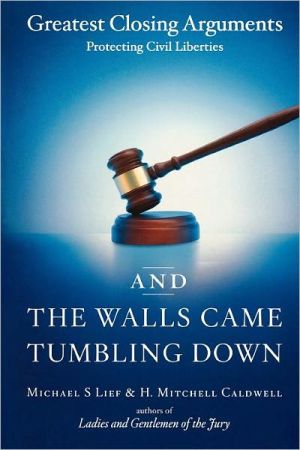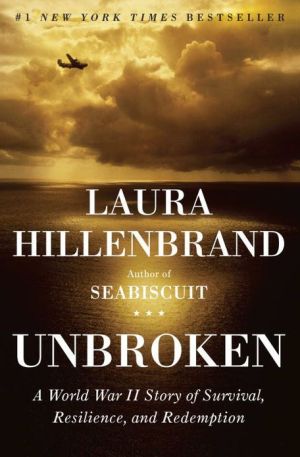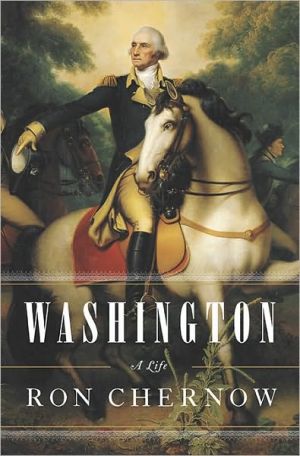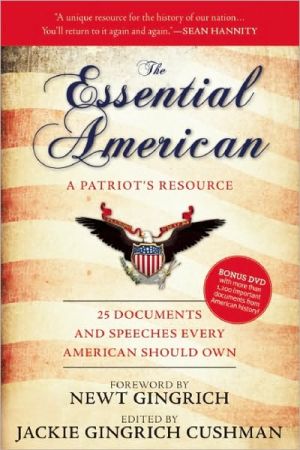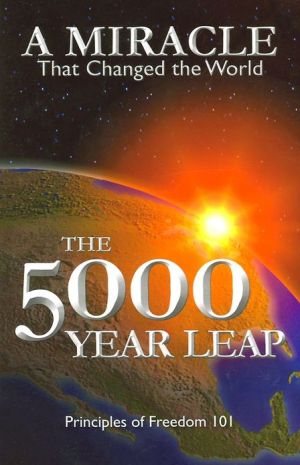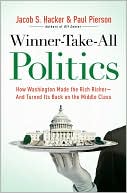And the Walls Came Tumbling Down: Greatest Closing Arguments Protecting Civil Liberties
The second volume in a must-have trilogy of the best closing arguments in American legal history\ Every day, Americans enjoy the freedom to decide what we do with our property, our bodies, our speech, and our votes. However, the rights to these freedoms have not always been guaranteed. Our civil rights have been assured by cases that have produced monumental shifts in America's cultural, political, and legal landscapes.\ And the Walls Came Tumbling Down showcases eight of the most exciting...
Search in google:
The second volume in a must-have trilogy of the best closing arguments in American legal historyEvery day, Americans enjoy the freedom to decide what we do with our property, our bodies, our speech, and our votes. However, the rights to these freedoms have not always been guaranteed. Our civil rights have been assured by cases that have produced monumental shifts in America's cultural, political, and legal landscapes.And the Walls Came Tumbling Down showcases eight of the most exciting closing arguments in civil law -- from the Amistad case, in which John Quincy Adams brought the injustice of slavery to the center stage of American politics, to the Susan B. Anthony decision, which paved the way to success for women's suffrage, to the Larry Flynt trial, in which the porn king became an unlikely champion for freedom of speech. By providing historical and biographical details, as well as the closing arguments themselves, Lief and Caldwell give readers the background necessary to fully understand these important cases, bringing them vividly to life. Publishers Weekly This primer on eight of the most influential civil rights cases in American history offers a lot more than just closing arguments. Such cases as those of the Amistad and Karen Ann Quinlan regarding the "right to die" are detailed and important parts of the trials discussed. The cases selected by the authors (Lief, a deputy DA in California; and Caldwell, a law professor at Pepperdine University, also coauthored Ladies and Gentlemen of the Jury) cover a wide range of civil rights issues from colonial times (John Peter Zenger) to the present, and the lawyers' words remain resonant: "[M]edicine must be the servant of man; and... technology must be the servant of medicine," argued Paul Armstrong in favor of allowing comatose Karen Ann Quinlan to die. In clear, concise introductions, the authors also give the necessary background to understand the cases: for instance, in discussing the right to die, the authors discuss the history of euthanasia. Some may quibble with the selected cases the Roe v. Wade case is omitted, for instance but the book offers a valuable walk through landmarks of American legal history. Agent, Eric Lasher. (Oct.) Copyright 2004 Reed Business Information.
And the Walls Came Tumbling Down\ Closing Arguments That Changed the Way We Live--From Protecting Free Speech to Winning Women's Suffrage to Defending \ \ By H. Mitchell Caldwell \ Scribner Book Company\ Copyright © 2004 H. Mitchell Caldwell\ All right reserved.\ ISBN: 0743246667 \ \ \ Introduction\ September 11, 2001. November 22, 1963. December 7, 1941. Americans of all ages remember where they were, what they were doing, when they first became aware of monstrous acts of murder and war. In an instant, everything changed. With a thunderclap -- the whine of jet engines, a rifle shot, and the screams of the doomed -- the nation loses its innocence yet again.\ But not every momentous paradigm shift is announced by the thundering hoofbeats of the Four Horsemen of the Apocalypse.\ Other events, more subtle, have changed the way we live. Profound, tectonic shifts in America's cultural, social, and legal landscape have taken place far removed in time and space from the glare of the media, experienced by a relative few who witnessed history being made. And, like a pebble tossed in a pond, these seemingly insignificant events -- writ small upon a canvas larger than any could then imagine -- send ripples out in ever-increasing circles, affecting us in ways impossible to foretell.\ A woman walks into a voting booth, casts her ballot, and is arrested by the police for the crime of voting. An anguished family asks a doctor to let their daughter die with dignity, only to be told the law won't allow it, the patient's wishes be damned. State doctors decide a young woman they deem of below-average intelligence must not be allowed to pass her defective intellect on to her children and order her forcibly sterilized.\ Years later, another woman casts her ballot without giving it a second thought and a man sits with his wife and signs a Do Not Resuscitate order before his operation. Every day millions of Americans enjoy the freedom to decide what they shall do with their property, their body, their speech, their vote, as a result of hard-fought battles won or lost over the last 150 years in courtrooms from Maine to California.\ When our society has attempted to untangle the Gordian knots of slavery or the right to die, the political process has often proved unable or unwilling to address these complex issues. Stepping into the breech were the men and women of the bar. When legislators will not or cannot legislate, Americans have turned to the judicial system. And so lawyers and judges have often been the first to tackle some of the most vexatious dilemmas to confront this nation. With twenty-twenty hindsight, we can say that sometimes they got it right (freeing the Amistad slaves), and sometimes they got it wrong (sterilizing Carrie Buck). But, again with hindsight, we know that these trials have helped bring us closer to resolving profound and complex problems that have faced the American people.\ The process has not changed over time. In the courtroom, the fundamentals of our democratic heritage and our future come together. It begins like this: The testimony is done; the witnesses have left. While the jurors sit waiting, an expectant hush falls over the room. The trial lawyer strides into the well and stands before them, pauses, then begins speaking. The jurors listen to the skillful interweaving of testimony, facts, storytelling, and analogy, some swept up in the words and rhythms of the advocate's argument, some taking notes, others just watching.\ The argument reaches a climax as the attorney asks, sometimes demands, that the jurors do the right thing. Then they retire to mull over all that they've seen and heard. And when they return to the courtroom, the judge asks, "Have you reached a verdict?" The foreperson stands and answers, "We have, Your Honor."\ Tension mounts. "What say you in the matter before this court?" As the answer echoes throughout the courtroom, the lives of all Americans are affected.\ We have collected summations from trials that have, without overstating the case, changed the way we live our lives. The arguments we have chosen for this book deal with issues that have defined our civil rights. Selected for the impact they have had upon American society, these represent the finest work of lawyers still famous and others now little known to the modern reader.\ We've edited many of the arguments for length. Our experiences in the courtroom have shown us that lawyers often go into fact-specific detail -- necessary perhaps for the jurors, but adding nothing to the reader's understanding and enjoyment. Wielding as delicate a knife as possible, we've excised those portions, leaving behind these marvelous summations. And, of course, nothing has been added.\ Until now, only the twelve jurors sitting in the box or the nine justices of the Supreme Court sitting on the bench have felt the full power of those words aimed at their hearts and minds. But now you can be in the courtroom, listen to some of the most important battles of all time, and ask, "What would I have done? How would I have voted?"\ Copyright © 2004 by Michael S Lief and H. Mitchell Caldwell\ \ Continues...\ \ \ \ Excerpted from And the Walls Came Tumbling Down by H. Mitchell Caldwell Copyright © 2004 by H. Mitchell Caldwell. Excerpted by permission.\ All rights reserved. No part of this excerpt may be reproduced or reprinted without permission in writing from the publisher.\ Excerpts are provided by Dial-A-Book Inc. solely for the personal use of visitors to this web site. \ \
Ch. 1To be or not to be : Karen Ann Quinlan and the right to die5Ch. 2The Amistad Odyssey : American courts decide if a free man can be forced into slavery61Ch. 3Enemy within : radio star John Henry Faulk challenges the McCarthy-era blacklist109Ch. 4A woman's rightful place : Susan B. Anthony casts a vote and battles for the ballot163Ch. 5The truth shall set you free : the English crown and colonial government try muzzling newspaper publisher John Peter Zenger and the fledgling American Press206Ch. 6The porn king and the preacher : Larry Flynt takes on the moral majority and becomes an unlikely champion for free speech242Ch. 7What price too high? : one woman's fight for survival against cancer - and her HMO299Ch. 8Cleansing the gene pool : Carrie Buck's forced sterilization and the limits on reproductive freedom355
\ Publishers WeeklyThis primer on eight of the most influential civil rights cases in American history offers a lot more than just closing arguments. Such cases as those of the Amistad and Karen Ann Quinlan regarding the "right to die" are detailed and important parts of the trials discussed. The cases selected by the authors (Lief, a deputy DA in California; and Caldwell, a law professor at Pepperdine University, also coauthored Ladies and Gentlemen of the Jury) cover a wide range of civil rights issues from colonial times (John Peter Zenger) to the present, and the lawyers' words remain resonant: "[M]edicine must be the servant of man; and... technology must be the servant of medicine," argued Paul Armstrong in favor of allowing comatose Karen Ann Quinlan to die. In clear, concise introductions, the authors also give the necessary background to understand the cases: for instance, in discussing the right to die, the authors discuss the history of euthanasia. Some may quibble with the selected cases the Roe v. Wade case is omitted, for instance but the book offers a valuable walk through landmarks of American legal history. Agent, Eric Lasher. (Oct.) Copyright 2004 Reed Business Information.\ \ \ \ \ Library JournalLief, a deputy district attorney in California, and Pepperdine law professor Caldwell have written a detailed examination of the closing arguments in eight prominent civil rights cases, including the Karen Ann Quinlan "right to die" case and Susan B. Anthony's conviction for attempting to vote. The book offers substantial detail about the cases and the lawyers, and its hallmark is the lengthy reprinting of closing arguments by distinguished lawyers such as Louis Nizer and Alexander Hamilton. The well-written text nicely places the cases in historical context. For nonlawyers, the question is how much to read about a given case. Alan M. Dershowitz's America on Trial covers two of the same cases (those of Anthony and John Peter Zenger) but takes eight pages instead of this book's nearly 80. For attorneys and those who love the law, And the Walls Came Tumbling Down is an excellent choice. The Dershowitz book is a good start for all others.-Harry Charles, St. Louis Copyright 2004 Reed Business Information.\ \
